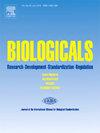Serum reactivity analysis with inactivated GVII-matched vaccine—Payavax G79®: Comparison of B-cell epitopes in NDV-vaccine strains
IF 1.5
4区 生物学
Q4 BIOCHEMICAL RESEARCH METHODS
引用次数: 0
Abstract
The Newcastle Disease Virus (NDV) sub-genotype VII.1.1 is the most common NDV circulating in Iranian poultry farms. It differs genetically and antigenically from the conventional vaccine strains of genotypes I and II. The inactivated vaccines efficiency can be affected by the grade of similarity with circulating viruses. Here, we updated the NDV vaccine using a local circulating virus seed, introduced Payavax G79® as the inactivated bivalent vaccine, and compared the results with serological and phylogenetic characteristics derived from it to different NDV genotype virus vaccines. According to our results, after 25 days post-vaccination, the antibody titer elicited against sub-genotype VII.1.1 was 8.4 log2. In contrast, the antibody titer against apathogenic genotype I (NDV-V4) and lentogenic genotype II (LaSota) was 4.4 log2 and 4 log2, respectively. Comparing in silico studies of the F protein's discontinued B-cell epitopes, it was found that NDV-GVII, LaSota, and NDV-V4 virus all have seven, four, and eight discontinued B-cell epitopes on the protein's surface. Furthermore, the HN protein surface of NDV-GVII, LaSota, and NDV-V4 virus has four, six, and three discontinued B-cell epitopes, respectively. In summary, the low similarity between NDV genotypes I, II, and the predominant circulating genotype VII (approximately 83–84 %) indicates the need for an updated vaccine seed strain.
灭活gvii匹配疫苗- payavax G79®的血清反应性分析:ndv疫苗株b细胞表位的比较
新城疫病病毒(NDV)亚基因型VII.1.1是在伊朗家禽养殖场传播的最常见的NDV。它在遗传和抗原性上不同于基因型I和基因型II的常规疫苗株。灭活疫苗的效力可能受到与流行病毒相似程度的影响。本研究采用当地流行的病毒种子对新城疫疫苗进行更新,引入Payavax G79®作为灭活二价疫苗,并将其与不同基因型新城疫病毒疫苗的血清学和系统发育特征进行比较。根据我们的结果,接种25天后,针对VII.1.1亚基因型的抗体滴度为8.4 log2。而对致病性基因型ⅰ(NDV-V4)和致病性基因型ⅱ(LaSota)的抗体效价分别为4.4 log2和4 log2。比较F蛋白的中断b细胞表位的计算机研究发现,NDV-GVII、LaSota和NDV-V4病毒在蛋白表面都有7个、4个和8个中断b细胞表位。此外,ndvv - gvii、LaSota和ndvv - v4病毒的HN蛋白表面分别有4个、6个和3个中断的b细胞表位。总之,NDV基因型I、II和主要流行基因型VII之间的相似性较低(约83 - 84%)表明需要更新疫苗种子株。
本文章由计算机程序翻译,如有差异,请以英文原文为准。
求助全文
约1分钟内获得全文
求助全文
来源期刊

Biologicals
生物-生化研究方法
CiteScore
3.70
自引率
0.00%
发文量
39
审稿时长
48 days
期刊介绍:
Biologicals provides a modern and multidisciplinary international forum for news, debate, and original research on all aspects of biologicals used in human and veterinary medicine. The journal publishes original papers, reviews, and letters relevant to the development, production, quality control, and standardization of biological derived from both novel and established biotechnologies. Special issues are produced to reflect topics of particular international interest and concern.Three types of papers are welcome: original research reports, short papers, and review articles. The journal will also publish comments and letters to the editor, book reviews, meeting reports and information on regulatory issues.
 求助内容:
求助内容: 应助结果提醒方式:
应助结果提醒方式:


